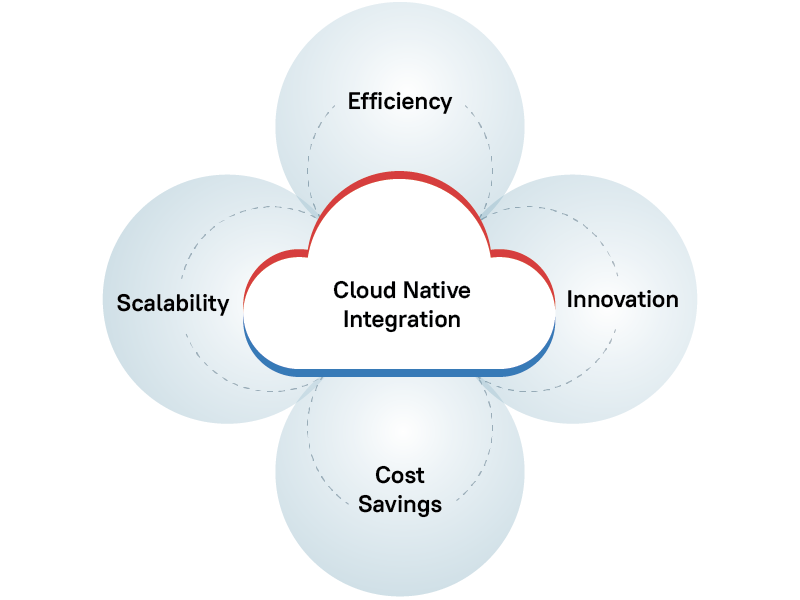As a crucial component of modern IT services, cloud-native data integration services help businesses manage and leverage their data in the cloud seamlessly. For businesses that provide IT services, understanding these services is essential for staying competitive and meeting clients’ evolving needs.
Cloud-native data integration services are tools, technologies, and practices that allow for the efficient and real-time exchange of data between various systems, apps, and databases located within a cloud computing environment. These services allow businesses to leverage the flexibility and scalability offered by cloud platforms.
Pros of Cloud-Native Data Integration Services
- Design, automate, and manage data workflows, thereby allowing data to flow seamlessly from source to destination, regardless of the data’s format or location.
- Allow for real-time data processing, which makes it easier to gain insights and make fast yet informed business decisions.
- Scale resources up or down as needed, thereby ensuring optimal performance and cost-efficiency.
- Protect sensitive data and meet regulatory requirements with robust security features and compliance measures.
- A wide range of connectors and APIs help connect with various applications, services, and data sources, fostering interoperability.
- Unburden the in-house teams with infrastructure management tasks, like server provisioning and maintenance to the cloud provider.
- Benefit from more free time for resources to focus on management and business development work and devote more time to understanding client expectations.
- Leverage cost savings by eliminating investment in physical premises, hardware and infrastructure, and operational overhead.
- Develop agility to adapt quickly to changing data needs and market demands.
Cons of Cloud-Native Data Integration Services
- Complexity: Implementing cloud-native data integration can be complex and requires skilled personnel to manage and maintain the process.
- Cost Management: If not closely monitored, cloud costs can spike, thereby potentially leading to unexpected expenses.
- Data Transfer Costs: Transferring large volumes of data to and from the cloud can incur additional costs, especially when dealing with high-latency connections.
- Privacy Considerations: Ensuring compliance with data privacy regulations, especially when handling sensitive or personally identifiable information.
- Integration Strategy: Developing a clear integration strategy and roadmap to align data integration efforts with business objectives.
- Data Governance: Implementing strong data governance practices to maintain data quality and consistency across the integration process.
- Cost Monitoring: Regularly monitoring cloud costs and optimizing resources to prevent budget overruns.
Cloud-native data integration has its share of complexities and cost management challenges. Considerations include working with proven service providers to maximize advantages while mitigating potential drawbacks.
Practical Case-Use Examples of Successful Cloud Native Data Integration

Several organizations have successfully leveraged cloud-native data integration to improve data flow and analytics and gain valuable business insights. Here are a few practical examples:
Netflix: The company utilizes the elasticity of the cloud to add storage as its customer base grows and usage increases. The cloud also helps the company increase its service availability.
Vodafone: From working on legacy systems with proprietary hardware requirements, the company moved to cloud-native for all their software. The company faced challenges with ensuring interoperability at the application level, needing new integrations, and challenges of high costs. However, with effective deployment, this shows how the company has prioritized efficiency and flexibility in its tech choices.
Capital One: The banking company decided to move to the cloud due to the security model, quick access to infrastructure, and the flexibility to handle purchasing demands at peak times.
They achieved greater resiliency and scalability, which allowed them to handle spikes in demand and avoid downtime.
These examples showcase how organizations across various industries have utilized cloud-native data integration to improve data-driven decision-making, improve user experiences, and drive business growth.
Working with Expert Assistance or Strategic Partners
Strategic partners bring specialized expertise and experience, thereby reducing the learning curve and minimizing potential errors. They are well-equipped in terms of infrastructural capabilities and trained and skilled expertise to design tailored solutions that align with the business’s specific needs and goals. This expertise helps businesses ensure efficiency in data flow and assist with business scalability and data security.
Strategic partnerships with a proven services provider also enable access to cutting-edge tools and best practices, which help businesses stay ahead of industry trends. Additionally, expert partners can provide ongoing support and troubleshooting assistance, thereby allowing IT businesses to focus on their core competencies while leveraging the full potential of cloud-native integration for greater agility and competitiveness.
Next Steps
- Learn more about the benefits of professionally managed data integration services and how these can help boost your business’s profitability.
- Email us at sales@analytix.com or call us at 781.503.9003 today.
- Follow our blog for industry trends and the latest updates.
- Engage with us on LinkedIn and Twitter.
